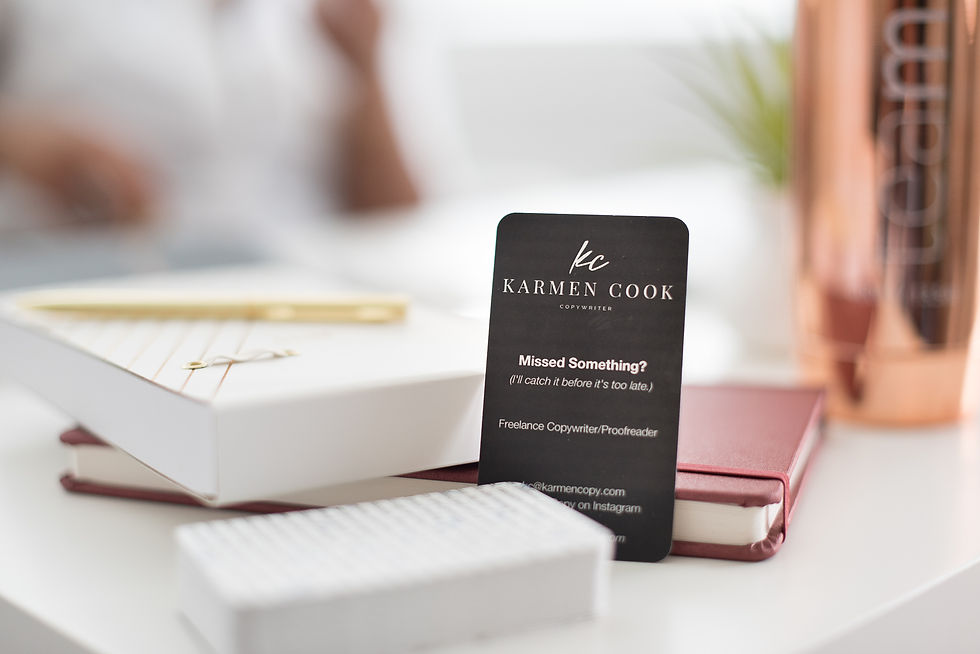5 Commonly Misused Phrases on Social Media Platforms | Copywriter Corner | Branding Tips
- Karmen Cook
- Feb 5, 2018
- 4 min read
I'm super excited when I get to collaborate with other awesome creatives! So, this amazing collaboration is the icing on the cake for me. I'm pleased to announced my new monthly series entitled Copywriter Corner with Karmen Cook of Karmen Copy! Each month she will be serving up lots of tips to help you create copy that will attract your ideal client. Raise your hand if you struggle with putting your thoughts into words on the page or have lots of ideas and struggle with organizing them then this series is for you! Better yet, go ahead and invest in your brand and reach out to Karmen today! Trust me...after reading this you will be hitting her up ASAP or at least following her blog too! So, enough from me. Let's see what Karmen has to say about 5 common misused phases on social media.

As a professional copywriter, I encounter so many websites, author bios, product descriptions and menus that could be improved with tightened copy alone. I always stress to my clients that using ALL the big words out in one copy block kills brand relatability in the end. No one wants to fight through piles of unnecessary words that sound good in search of the actual point you’re trying to make. I’m an online shopaholic, and I’ve abandoned many a shopping cart because I’ve gone to a contact or brand bio page and gotten vibes of everything being haphazardly smashed together the night before in order to “secure the bag.”*
In a world of social media where engagement rules supreme, you want to make sure that people are engaging for positive reasons right? Good online copy is punchy and flavorful. It communicates your ask (ex. “Join my email list,” “Download my free guide”) in a stylish way that piques a potential customer’s interest enough for them to say “Hey! I’d love to learn more!” What happens, though, when you rely heavily on turns of phrase, idioms, and clichés as filler text to beef up your online chatter? The engagement quality is affected (as in, people probably aren’t double tapping your pics because they’re too busy screenshotting the drawn-out caption on your post that’s full of errors), and as a result the coins might change from a steady flow to a slow drip.

A sprinkling of cliche here and there isn’t terrible, especially in online customer interactions. Sometimes our words just require a bit more seasoning, and it’s natural to throw one in occasionally. What you WON’T be out here doing, though, is misusing some of the most basic phrases incorrectly. The digital streets are always watching your branded and personal accounts, so don’t get caught slipping.

Let’s start with the top five misused phrases that I notice in everyday social media conversations on platforms like Facebook:
“Taken for granted”- So often I see “taken for granite.” Like...a type of ROCK. Really sit with this one. How do you regard something as a rock exactly? The phrase when used correctly actually means that feelings of indifference are observed in relation to a person or thing.
“Couldn’t care less”- Social media is full of people who “could care less,” but what they’re really saying is that they DO still care on some level. Using the incorrect version says that there’s still a lower level of care that you can descend to. Used correctly means that you’ve already reached that limit and have nothing left to pay a situation or person besides dust.
“All intents and purposes”- I see “all intensive purposes” a lot, but what about the non-intensive kind? They need love too! Used correctly, this phrase acts as a catch-all to refer to all intended uses and goals. Think of it as a phrase that gives a nod to all practicalities.
“Could’ve/ Should’ve/ Would’ve”- These contractions mean “_____ have.” As in, “I should have set my alarm last night, because now I’m running late.” Although it sounds like the word “of” is part of the mix, remember that “of” is an indication of relationship. Think of it as a reference to something being part of a whole if that helps.
“To each his own”- Used correctly, the phrase confirms that each person has a right to their personal preferences. To keep things gender-neutral, you might also see “To each their own” as well. An “it” can’t have a personal preference since the word is typically used as a descriptor of something inanimate, so saying “to each its own” in reference to people would be incorrect.

*A new phrase the kids are using these days. Drop that inside an Instagram post while it’s still hot. You’re welcome. -KC
Did any of these throw you for a loop? Wanna talk about it? Head straight for those comments below and let’s get to it!

Thanks for reading, and please share the love with anyone managing their own online content!

Now, if the thought of writing your own copy makes you gag, cry, fall asleep then connect with Karmen on her website right here! You can also find her on Instagram!

Are you ready to take your brand to the next level and connect with your ideal client? Wait no longer!
Set up your branding session right here! Also, there is a new collaboration with Karmen what will coming your way soon! Get ready to have a bangin' "About Me" page on your website!
LOVE>PEACE+LIGHT,
Sirena













































Comentarios